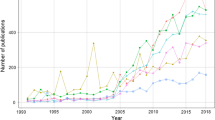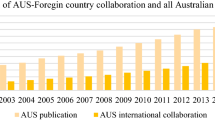Abstract
This paper aimed to present the profile of the researchers, the pattern of scientific collaboration and the knowledge organization in the area of information science in Brazil. The study covered sex differences, skills by region and type of institution, academic formation, indicators of productivity, relations of co-authorship, interactions with other fields of knowledge, and sectors of application of the researches developed in the area. The survey, covering the period 2000–2010, was based on information from the curricula vitae of the researchers with Research Productivity Grant funded by a government agency and from the Directory of Research Group of the National Council for Scientific and Technological Development. The results revealed that the majority of the researchers are women, both in research and postgraduate; there is a significant regional asymmetry; the studies are concentrated in public universities; the papers are published mainly in national journals with open access; the scientific production follows the same pattern of the areas of humanities, social sciences, and linguistics, literature and arts; there is a tendency of increasing the incidence and extent of co-authored papers; there is interaction with other 20 areas of knowledge, which are directly or indirectly connected, forming a single component that comprises all of them; and ‘information and S&T management’ followed by ‘education’ are the main sectors of application of the studies developed by the Brazilian researchers. The study therefore showed an overview of this scientific community seeking to contribute to a better understanding of its characteristics and specificities.




Similar content being viewed by others
References
Acedo, F. J., Barroso, C., Casanueva, C., & Galán, J. L. (2006). Co-authorship in management and organizational studies: an empirical and network analysis. Journal of Management Studies, 43(5), 957–983.
Aharony, N. (2012). Library and information science research areas: a content analysis of articles from the top 10 journals 2007–8. Journal of Librarianship and Information Science, 44(1), 27–35.
Ardanuy, J. (2012). Scientific collaboration in library and information science viewed through the web of knowledge: the Spanish case. Scientometrics, 90(3), 877–890.
Bufrem, L. S., Gabriel Junior, R. F., & Gonçalves, V. (2010). Práticas de co-autoria no processo de comunicação científica na pós-graduação em ciência da informação no Brasil. Inf. Inf., 15, 111–130.
De Souza, C. G., & Barbastefano, R. G. (2011). Knowledge diffusion and collaboration networks on life cycle assessment. International Journal of Life Cycle Assessment, 16(6), 561–568.
Erdmann, A. L., & Lanzoni, G. M. M. (2008). Características dos grupos de pesquisa da enfermagem brasileira certificados pelo CNPq de 2005 a 2007. Esc Anna Nery Rev Enferm, 12(2), 316–322.
Fernandes, W. R., Cendón, B. V., & Araújo, C. A. A. (2011). Ciência da informação e áreas correlatas: um estudo de caso na Universidade Federal de Minas Gerais. Brazilian Journal of Information Science, 5(1), 3–36.
Foucault, M. (1966). Les Mots et les Choses. Une Arquéologie des Sciences Humaines. Paris: Gallimard.
Glänzel, W. (2002). Coauthorship patterns and trends in the sciences (1980–1998): a bibliometric study with implications for database indexing and search strategies. Library Trends, 50(3), 461–473.
Gomes, M.Y.F.S. de F. (2009). Desafios Atuais da Ciência da Informação no Brasil. Perspectivas em Ciência da Informação, 14(3), 190–205.
Hawkins, D.T. (2001). Bibliometrics of electronic journals in information science. Information Research, 7(1). http://InformationR.net/ir/7-1/paper120.html. Accessed 20 Jan 2012.
Hou, H., Kretschmer, H., & Liu, Z. (2008). The structure of scientific collaboration networks in scientometrics. Scientometrics, 75(2), 189–202.
Huang, M. H., & Chang, Y. W. (2011). A study of interdisciplinarity in information science: using direct citation and co-authorship analysis. Journal of Information Science, 37(4), 369–378.
Huang, M. H., & Chang, Y. W. (2012). A comparative study of interdisciplinary changes between information science and library science. Scientometrics, 91(3), 789–803.
Johnson, I., & Cano, V. (2008). Electronic publishing in librarianship and information science in Latin America—a step towards development? Information Research, 13(1). http://InformationR.net/ir/13-1/paper331.html. Accessed 15 Feb 2012.
Katz, J. S., & Martin, B. R. (1997). What is research collaboration? Research Policy, 26, 1–18.
Kuhn, T. S. (1997). A estrutura das revoluções científicas. São Paulo: Perspectiva.
Laband, D. N., & Tollison, R. D. (2000). Intellectual collaboration. Journal of Political Economy, 108(3), 632–662.
Lane, J. (2010). Let’s make science metrics more scientific. Nature, 464, 488–489.
Larivière, V., Sugimoto, C. R., & Cronin, B. (2012). A bibliometric chronicling of library and information science’s first hundred years. Journal of the American Society for Information Science and Technology, 63(5), 997–1016.
Leite, P., Mugnaini, R., & Leta, J. (2011). A new indicator for international visibility: exploring Brazilian scientific community. Scientometrics, 88(1), 311–319.
Leta, J., Glänzel, W., & Thijs, B. (2006). Science in Brazil. Part 2: sectoral and institutional research profiles. Scientometrics, 67(1), 87–105.
Marteleto, R. M. (2009). A pesquisa em Ciência da Informação no Brasil: marcos institucionais, cenários e perspectivas. Perspectivas em Ciência da Informação, 14(especial number), 19–40.
MCTI—Ministry of Science, Technology and Innovation. (2012). Indicadores—Comparações internacionais. http://www.mcti.gov.br/index.php/content/view/740.html?execview. Accessed 8 Aug 2012.
Morillo, F., Bordons, M., & Gomez, I. (2001). An approach to interdisciplinarity through bibliometric indicators. Scientometrics, 51(1), 203–222.
Mukherjee, B. (2010). Assessing Asian scholarly research in library and information science: a quantitative view as reflected in web of knowledge. The Journal of Academic Librarianship, 36(1), 90–101.
Pinheiro, L. V. R. (2000). Infra-estrutura da pesquisa em Ciência da Informação no Brasil. DataGramaZero—Revista de Ciência da Informação, 1(6), 1–30.
Pinheiro, L.V.R. (2006). A ciência da Informação: desdobramentos disciplinares, interdisciplinares e transdisciplinares. In: Gonzàles de Gómez, M.N., Orrico, E.G.D. (Org.). Políticas de memória e informação: reflexos na organização do conhecimento (pp. 111–141). Natal: UFRN Edit.
Porter, A. L., Cohen, A. S., Roessner, J. D., & Perreault, M. (2007). Measuring researcher interdisciplinarity. Scientometrics, 72(1), 117–147.
Porter, A. L., & Rafols, I. (2009). Is science becoming more interdisciplinary? Measuring and mapping six research fields over time. Scientometrics, 81(3), 719–745.
Prebor, G. (2010). Analysis of the interdisciplinary nature of library and information science. Journal of Librarianship and Information Science, 42(4), 256–267.
Smith, L. (1992). Interdisciplinarity: approaches to understanding library and information science as an interdisciplinary field. In: P. Vakkari & B. Cronin (Eds.), Conceptions of library and Information Science: historical, empirical and theoretical perspectives (pp. 253–267). London: Taylor Graham.
Tang, R. (2004). Evolution of the interdisciplinary characteristics of information and library science. Proceedings of the American Society for Information Science and Technology, 41(1), 54–63.
Vanz, S.A. de S., & Stump, I.R.C. (2010). Colaboração científica: revisão teórico-conceitual. Perspectivas em Ciência da Informação, 15(2), 42–55.
Vasconcelos, S. M. R., Sorenson, M. M., & Leta, J. (2009). A new indicator for the assessment of Science & technology research? Scientometrics, 80(1), 217–230.
Vilan Filho, J. L., de Souza, H. B., & Mueller, S. (2008). Artigos de periódicos científicos das áreas de informação no Brasil: evolução da produção e da autoria múltipla. Perspectivas em Ciência da Informação, 13(2), 2–17.
Acknowledgments
The authors thank the anonymous reviewers for their comments and suggestions on the manuscript.
Author information
Authors and Affiliations
Corresponding author
Rights and permissions
About this article
Cite this article
de Souza, C.G., Ferreira, M.L.A. Researchers profile, co-authorship pattern and knowledge organization in information science in Brazil. Scientometrics 95, 673–687 (2013). https://doi.org/10.1007/s11192-012-0882-7
Received:
Published:
Issue Date:
DOI: https://doi.org/10.1007/s11192-012-0882-7




